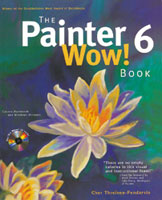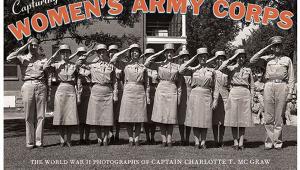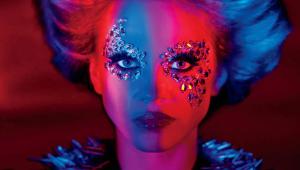Digital Imaging Books
| From cuneiform to scrolls to illuminated manuscripts, books in some form or another have been with us for centuries, whether it's a 10 volume set of the Complete Self-Instructing Library of Practical Photography that was published in 1909 or the brand new Painter Wow! book. But are books as we know them doomed? With the introduction of Microsoft's ClearType technology and book-like electronic devices, such as HP's Pocket PC, that can display e-books in an easily transportable package, digital pundits have started portraying traditional books as old technology. At Seybold San Francisco, the e-book battle heated up. First, Adobe announced it would acquire Glassbook, Inc., developers of the Glassbook Reader, Plus Reader, and Content Server that competes with Microsoft's e-book technology. Microsoft countered by announcing its deal with Amazon.com to make Microsoft Reader the preferred format for e-books the Internet bookseller distributes and will offer a customized version of Reader to Amazon's e-book customers. A few months ago I attended Book Expo America, the industry trade show for the book business and had a chance to peek behind Oz's curtain to see what really makes the world of books go 'round. I can report to you that while the show made a few concessions to the existence of e-books and high-tech methods for printing conventional books, the industry appears happily rooted in the 19th century the way it has been for some time, but this is sure to change. Stephen King's recent successful foray into e-publishing, first with Riding the Bullet and more recently with The Plant, has made a few publishers sit up and take notice. Carolyn Reidy, President of Simon and Schuster, said that "It writes in the largest possible letters that publishers must prove their value in finding an author his or her audience and doing it better than the author can do by his or her self." The plans for my new web site include an e-book section and perhaps in the 2001 version of this story, I will be able to mention a few e-books about digital imaging. In the meantime, my friends, e-books and their other digital kin will only replace their paper versions when you can stick a compact, batteryless device into a tote bag with a few soft towels and sunscreen and take them to the beach. We aren't there yet, but books as we know them are going to change--and soon. In the meantime, here are some of the best digital imaging books I found this year. |
|
General Digital Reading.
The big 9x11" pages are full of great-looking photographs, wrapped around an attractive design with text that both instructs and inspires. The author tackles many aspects of digital imaging with an introduction that includes information on selecting computers and digital cameras for capturing images. These topics are covered in easily digestible bits that won't scare off the digital newbie and even intermediate-level pixographers might learn a new trick or two. The heart of the book is found in the image-oriented sections, including a chapter called "Digital Shooting" that includes tips on making the transition from using film to capturing pixels. "Revitalizing Existing Images," like the rest of the book, includes a few tasteful nude images that only those who cannot tolerate the nude image in any form will find offensive. The "Picture Processing" chapter is effective in showing how to manipulate black and white or color images, and with the exception of the "Framing Images" section, which ignores the many useful "Frame" plug-ins available, is only one page in what is otherwise a well produced book. The "Master Class" section takes you into the studios of various digital imagers showing the hardware, software, and techniques they use to create the images on display. Not to be missed are Catherine McIntyre's stunning images. The Art of Digital Photography covers a cornucopia of digital imaging topics from travel photography to making prints and exhibiting your finished work. A final chapter on "Under-standing the Technology" might be better located in the front, but my guess is the publisher put it in the back so they wouldn't scare beginners and could still give more advanced readers all the technical detail they might want. The book wraps up with a somewhat comprehensive Glossary of technical terms. |
|
Photoshop 5 & 5.5 Artistry by Barry Haynes and Wendy Crumpler. Published by New Riders, 201 W 103rd St., Indianapolis, IN 46290; www.newriders.com; 408 pages; $55.00; softbound. (ISBN 0-7357-0994-7) With a price tag of $55, this book isn't cheap but it's simply the best book currently available about Adobe Photoshop. (Amazon.com sells it for $44.) This latest edition has added information on Version 5.5 as well as ImageReady 2.0 which comes bundled with the software. The book has also grown 48 more pages than last year's version. The CD-ROM, on the other hand, is the same. This is a gorgeous book, filled with great images, even though some of us who photograph people might like more tutorials on working with portrait images. In addition to all of the "how stuff works" sections you expect to find in books like this, there are "hands-on sections" sprinkled throughout the book, that show you before and after images as well as all the steps and background on how these effects were created. The learning process is helped by excellent quality reproduction on great-looking paper. The back of the book is filled with useful sections on working with Image-Ready, and takes most of the mystery out of using this program, although the quality of the example images used here are not up to what appears in the rest of the book. These few quibbles aside, this remains the most useful book about Photoshop that's aimed at photographers. The day I wrote this, Adobe Systems announced Photoshop 6.0 and ImageReady 3.0, so I'm looking forward to a new, updated version of this useful volume. |
|
Digital Masters by Bert Monroy. Published by New Riders, 201 W 103rd St., Indianapolis, IN 46290; www.newriders.com; 256 pages; $49.99; softbound. (ISBN 0-7357-0969-6) This oversized book is subtitled "Photorealistic Techniques with Photoshop and Illustrator" and the author is concerned more with creating original images from scratch than using original photographs. Even though a few photographs do appear in the book, they are mostly used as elements (or examples) in some of the author's creations. Even the author's self-portrait that's used to create a reflection in a store window is a drawing he made in Photoshop. Nevertheless, this is still one of the best digital imaging books of the year because its pages unlock the secrets of many of Photoshop's tools when used in an illustration environment. Its large (10x10") page size allows for lavish four color reproduction of everything from digital paintings (don't miss "Growing Some Beans" on page 171) to large screen shots of dialog boxes. For once, you can see them at a size that makes understanding how all of the controls really work. The book is highlighted by excellent overall design and text that's to the point. Monroy doesn't try to show how clever he is; he simply and completely explains how the illustrations on each page relate to a project or accomplish an effect. While not for all digital imagers, Monroy's Digital Masters is an excellent book for those photographers who want to take digital imaging one step beyond. |
|
Wow! Books. No series of digital imaging books has reached the standards of excellence set by Peachpit Press' Wow! books, and The Photoshop 5/5.5 Wow! Book is no exception. This book follows the series' format by packing lots of information along with well-reproduced full color screen shots and examples that clearly show readers how to accomplish a specific imaging task or effect. As in previous editions, there is a comprehensive section showing the effects of various filters, including those built into Photoshop as well as third party plug-ins, some of which are available in demo versions on the Mac OS/Windows-compatible CD-ROM that's included. In addition to showing how these filters look when applied to a standard image, the authors offer hints that will help you get the most out of those plug-ins, such as using the Difference Clouds filter to create a marble-looking effect. The book is chock full of tips, like how to use Photoshop's Layers function to create a "repairs" layer to help fix a problem image without working directly on the photograph itself. No matter what level of digital imager you might be, The Photoshop 5/5.5 Wow! Book remains an indispensable resource. |
|
The Painter 6 Wow! Book by Cher Threinen-Pendarvis. Published by Peachpit Press, 1249 Eighth St., Berkeley, CA 94710; www.peachpit.com; 360 pages; $49.99; softbound, includes CD-ROM. (ISBN 0-201-35449-7) While aimed more at the digital illustrator than the digital imager, this book is useful for those photographers who have been trying to master a program that has the steepest learning curve of any bitmapped graphics program out there. Painter is built on the concept of using natural drawing tools and materials to create images, and the author has done a masterful job of explaining an interface that, while vastly improved over previous versions, is anything but intuitive. Following the Wow! format there are tutorials showing how the various commands function, along with lavish illustrations showing each step for accomplishing an effect. The chapter on "Enhancing Photos, Montage, and Collage" starts with basics such as sepia toning a photograph but moves onto toning with textures and digital hand-tinting, something that's easier to accomplish for many users in Painter than Photoshop. There's even a chapter on using Painter with Photoshop, showing how the synergies developed between the two programs can be used to create collages and composite images. While Painter has bounced around between several companies and now resides in The Great White North with Corel, which I think bodes well for its future of the product, The Painter 6 Wow! Book should serve as a guidebook for any digital imager who is looking to expand their horizons. |
|
Reference And Technical
Tomes. Stylistically poles apart from the Wow! books is Photoshop in a Nutshell, which follows the typical O'Reilly standard of using a stodgy, almost textbook-like design that is chock full of complete, well-written and comprehensive text. This second edition of the book is current for Adobe Photoshop 5.0, so it lacks the web orientation of 5.5 and restyled interface and new features of Version 6.0. Nevertheless, the book remains a useful desktop reference for users of Photoshop 5.0 who need to know how a tool or command works. Instead of superficial explanations, author O'Quinn delivers all of the details you need to know to answer those nagging questions, like, "How do all of those options in the Levels dialog work?" You'll find it here in clear, no-nonsense prose. There are no color images and the few illustrations are limited to screen shots of dialog boxes, but after reading a specific section you will actually be able to understand what all of these sliders and choices are, how they work, and why they work the way they do. While most of the book serves as a reference tool for using Photoshop, the author includes an appendix that he modestly calls "Common Techniques" in which he shows readers how to create some decidedly uncommon effects in the clear, lucid style that illuminates the rest of Photoshop In a Nutshell. |
|
The Book of SCSI (second edition) by Gary Field, Peter Ridge, et al. Published by No Starch Press, 555 De Haro St., Ste. 250, San Francisco, CA 94107; www.nostarch.com; 400 pages; $49.95; softbound, includes CD-ROM. (ISBN 1-886411-10-7) While skeptics might think that The Book of SCSI would hardly be a page turner, digital imaging realists know that all of the SCSI-based peripherals they have connected to their computers are not going to disappear overnight. As popular as USB may be, it is still slower than SCSI, and while FireWire (IEEE 1394) may be faster, most computers, except Apple, Sony, and a few forward thinking companies have not adopted this more expensive technology. And while SCSI has its quirks, so does, it turns out, USB. If you have any SCSI devices hooked up to your computer, you should have a copy of this book and CD-ROM. You don't need to read it like a novel; the average user might just want to skim through the text to be aware of its content so they know where to look when they have a SCSI-based problem. Technically inclined readers will want to devour the content like the latest John Grisham novel. In short, there's something here for users of any SCSI devices and the more SCSI devices you have connected, the more you need this book. |
|
Preparing Digital Images for Print by Sybil Ihrig and Emil Ihrig. Published by Osborne McGraw-Hill, 260 Tenth St., Berkeley, CA 94710; 162 pages; $21.95. (ISBN 0-07-882146-0) Not every digital imager needs to know how to prepare their images for print, but if you do, you already know that there are not many references available on this topic. One of the best is Preparing Digital Images for Print. The book opens with a look at the fact that not all digital images are created equal with many of them coming from many different sources, but all need to be properly processed in order to produce the results on the printed page that their creator intended. The book goes into all of the variables that ultimately affect the image quality on the page including color management, screening, and separations. You'll also find useful chapters on working with image-editing programs as well as the technical requirements for working with large file sizes. The book is nicely designed with lots of mostly gray scale illustrations, although there's a color section in the middle of the book that will help readers find their way through the mine field of technical considerations that await them when tweaking image files for print. Where To Buy These Books? True story: I had a reader call and tell me how he went into a camera store that had a good selection of photo and digital imaging books but couldn't find a copy of one of my new books. When he asked a salesperson about it, he was told, "We had one of his books, but we sold it." Sometime after this incident, my wife, Mary, visited the store owner along with copies of some of my recent books. Now, they have most of my in-print books in stock and have expanded their book section, but Mary can't go around the country raising the awareness of every camera store owner. If you have a local book or camera store that has a good selection of photography and digital imaging books, support them by purchasing and ordering books. If you don't, use the Internet to find what you're looking for. Amazon.com does an excellent job of stocking and shipping photographic and digital imaging titles, including those from authors whose names regularly appear on this magazine's masthead. While you may have to pay shipping costs, the books are often discounted enough to make it an attractive purchase. For out of print or unusual photo books, you should check out Petra Kellers' Photo/ACR Book Service at www.camerabooks.com or A Photographers Place, 133 Mercer St., NYC, NY 10012; (212) 431-9358. The books, as Fox Mulder might say, are out there. You may just need to look a little harder than you think you should. |
- Log in or register to post comments

























































